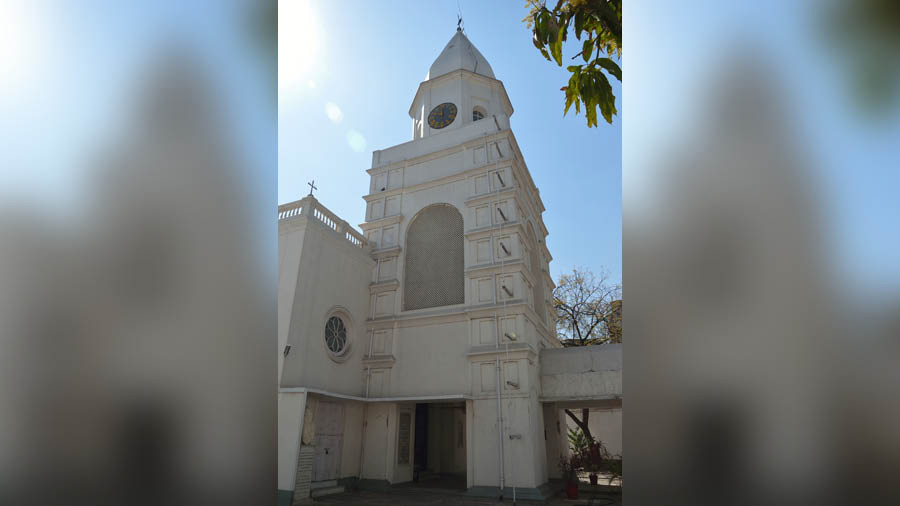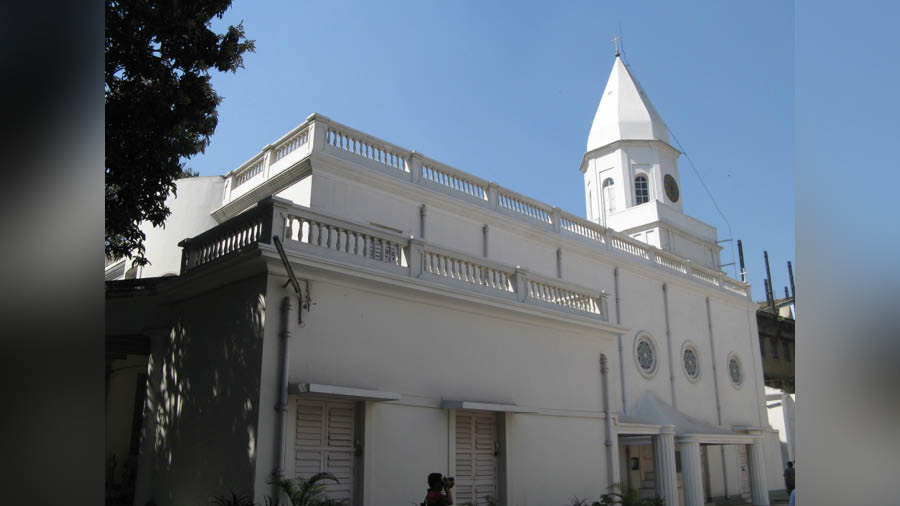Hidden inside the chaos of Kolkata’s business district, right next to Brabourne Road flyover, is an oasis of peace and calm. Shaded by jamun and mango trees, an old church hides in plain sight.
On any day except Sunday, you will have to wade through a literal ocean of humanity before you arrive here. This is the Armenian Church of the Holy Nazareth — recognised as the oldest church in Calcutta.
It is believed that the original church building — a small wooden structure — was built around 1688. It burnt down in a devastating fire in 1707. The campus was originally a graveyard for the Armenian community. The present church building came up on this graveyard in 1724. If you visit it today, you will find scattered around the church building old tombstones. One of these has piqued the interest of historians for years now and led to much debate and discussion without a definite resolution.
The Armenians have a long history with the subcontinent. The first documented arrival is of a trader named Thomas Cana who reached Malabar in 780 AD. The Ottoman and Safavid conquests of the Armenian lands in the 15th century led to a mass exodus of the community from their motherland and many landed in Mughal north India. One of the more illustrious ones was Abdul Hai who became the Chief Justice of Emperor Jalaluddin Akbar. Slowly, they spread away from Agra to other provinces like Punjab and Bengal. Many Armenians worked as officers in the armies of native rulers.
As winds of fortune showed signs of diversion from the Mughal dynasty to European powers, the Armenians were quick to sniff it. On June 22, 1688, a treaty was signed in London between the English East India Company and the Armenian community in India that granted favourable trading rights to the community as well as equal rights with British subjects regarding the freedom of residence, travel, religion and unrestricted access to civil offices. It coincides well with the construction of the church in what would become the metropolis of Calcutta.
But hidden behind the church building, lies a gravestone that throws up the logical flow of time into a whirlwind. Mesrovb Jacob Seth, the 19th century Armenian historian and writer decoded the gravestone’s message as below:

The tombstone Trinanjan Chakraborty
This is the tomb of
Rezabeebeh
Wife of the Late Charitable Sookias
Who departed from
This World to
Life Eternal
On the 11 th July, 1630
The year mentioned is 60 years before Job Charnock’s famous landing somewhere near present-day Nimtolla Ghat that put in motion events that saw three small hamlets transform into the second most important city in the entire British Empire. But does it mean that as early as 1630, in the second year of Emperor Shah Jahan’s rule, there was a community of Armenians in this region – back then dominated by forests, marshlands and swamps?
We look for answers to the writings of Mesrovb Jacob Seth. He writes, “Armenians formed their first settlement in Bengal in the year 1665 by virtue of a farman issued by Moghul Emperor Aurangzeb granting them a piece of land at Saidabad, with full permission to form a settlement there.” This does seem to rule out the possibility of an Armenian settlement in what would become Calcutta in future back in 1630. But then how does one explain this oddity?
The simplest explanation is that maybe Mesrovb Jacob Seth made a mistake while translating. After all, the inscriptions on the original gravestone may have become eroded with time so it is not entirely impossible that such a mistake might take place. But Mesrovb Jacob Seth was a foremost authority on Armenian history in the subcontinent and him making such a mistake while not impossible, certainly seems improbable.
In the 18th century, a rich Armenian businessman of Calcutta by the name of Catchick Arakiel sponsored refurbishing of the interiors of the church, construction of a watch-tower, residents for priests and erection of boundary walls for the compound. His son, Agah Moses Catchick Arakiel wrote a letter to an Englishman of the name Hawksworth in 1801. The latter got the letter published in The East Indian Chronologist. Agah Moses writes, “…Shortly after establishment of Calcutta by the English, the Armenians settled amongst them….” This also lines up with the signing of the trade treaty in London in 1688. It is worthwhile noting here that except that of Rezabeebeh, there is no other tombstones in the Church compound that date back to the 17th century.

The clock tower at the Armenian Holy Church of Nazareth Wikimedia Commons
Writing on this matter, the famous historian Professor CR Wilson states, “Regarding the earliest grave of an Armenian churchyard in Calcutta, the tombstone is dated 11th July, 1630 AD. This has been taken as showing that the Armenians were established in Calcutta as early as 1630. The inference does not seem valid. The instance is isolated. No other tombstones in the churchyard are dated earlier than the 18th century. There is nothing to show the stone is situ. It may well have been brought to Calcutta from elsewhere…..Even if the stone is in situ, it does not prove the existence of an Armenian colony. In India, a person must be buried where he dies. If an Armenian voyager died in a ship near Calcutta, it would be necessary to bury the body here.”
Mesrovb Jacob Seth does mention that Armenians had trade relations with the Dutch at Chinsurah as early as 1645. So it does seem probable that Rezebeebeh mostly died while on a ship voyage somewhere on the Hooghly and was buried on the nearby coast. Years later, when the Armenian community built a settlement in the region, her grave was possibly moved to their graveyard.
While this does seem the most likely explanation, not everyone is satisfied. Thus, the mystery of Rezabeebeh Sookias’ grave continues to this day. But then again, isn’t life rather dull without a whiff of mystery.
Be as that may, if you have never been to the Armenian Church, I do recommend a visit. And do make a point to check out the most mysterious tombstone in Calcutta.
Reference: Kolikata Dorpon (Calcutta Mirror) – Volume I by Radharaman Mitra
